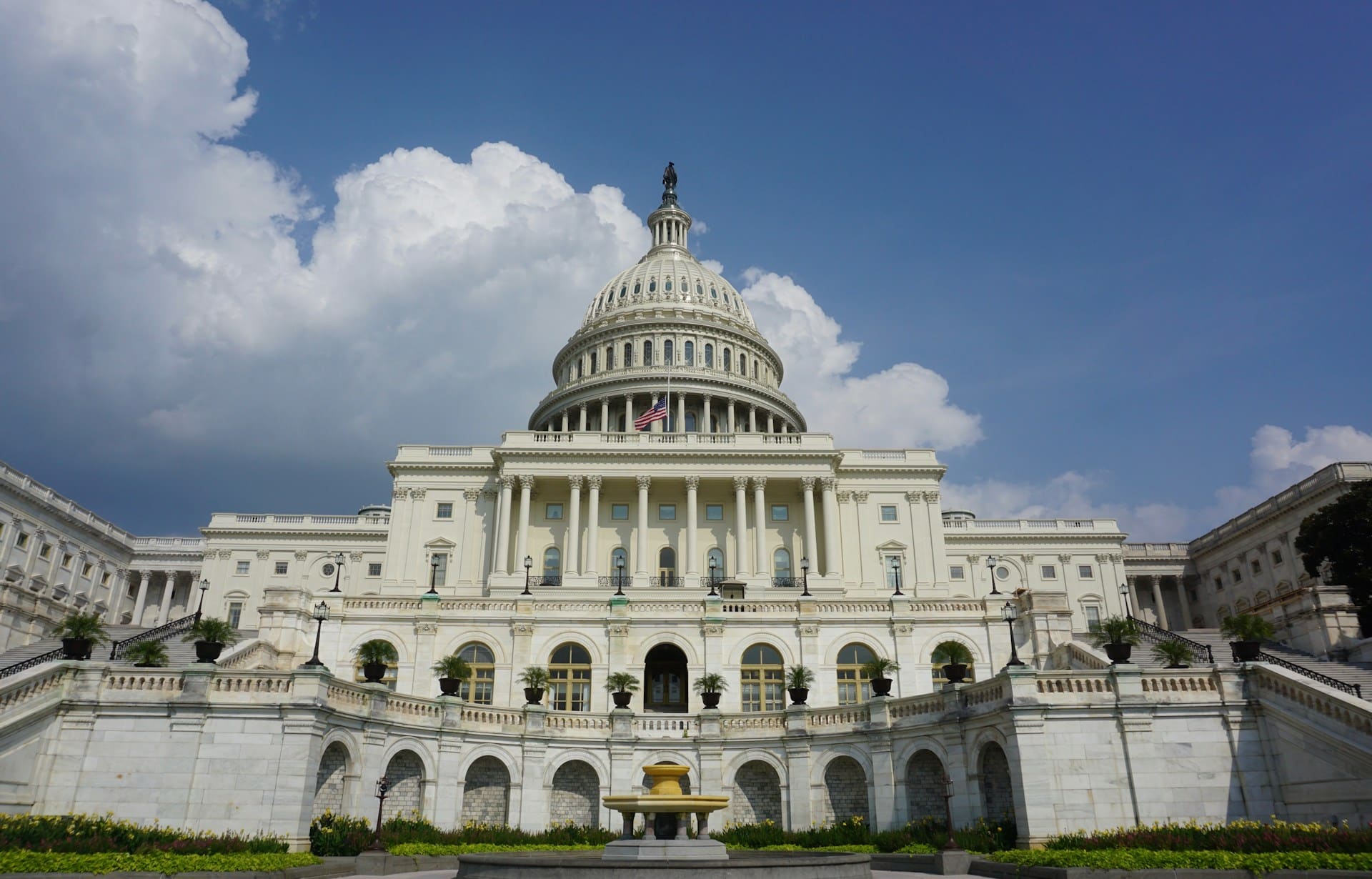In what might be considered a victory, the passage of another continuing resolution comes with its own kind of damage. TCS Director of Research and Policy Josh Sewell joins host Steve Ellis for a discussion about how taxpayers stand to lose from the passage of a clean CR.
Transcript
Announcer:
Welcome to Budget Watchdog All Federal, the podcast dedicated to making sense of the budget, spending and tax issues facing the nation. Cut through the partisan rhetoric and talking points for the facts about what’s being talked about, bandied about and pushed to Washington. Brought to you by Taxpayers for Common Sense. And now the host of Budget Watchdog AF TCS President Steve Ellis.
Steve Ellis:
Welcome to All American Taxpayers Seeking Common Sense. You’ve made it to the right place. For over 25 years, TCS, that’s Taxpayers for Common Sense, has served as an independent nonpartisan budget watchdog group based in Washington DC. We believe in fiscal policy for America that is based on facts. We believe in transparency and accountability because no matter where you are on the political spectrum, no one wants to see their tax dollars wasted. As the countdown clock to a government shutdown ticks ever closer to zero hour, there is much to consider my friends. In what may be at this moment considered a victory, the passage of yet another continuing resolution comes with its own kind of damage, the kind of damage that is all too easy to overlook, the kind of damage that comes from negligence, and a failure to make even the most minor yet necessary adjustments to how you operate. Joining me to explain how taxpayers stand to lose, even from the passage of a clean CR is Joshua Sewell, TCS’s Director of Research and Policy. Welcome to the podcast, Josh.
Josh Sewell:
Thanks, Steve. It’s not just about losing. I have some bright things as well.
Steve Ellis:
All right, well Josh, let’s start with its status. Check the countdown clock still has time on it. The new speaker’s in the driver’s seat. Can he avoid the shutdown?
Josh Sewell:
Maybe.
Steve Ellis:
Okay, that’s some deep insight there. Why a maybe?
Josh Sewell:
Well, the current CR expires on November 17th, and so that’s just a couple of days away. And when I checked a while ago, it appears there’s not a lot of, we’ll call it love for the speaker’s current CR proposal. There’s definitely not unity amongst Republicans. Well,
Steve Ellis:
With margins as tight as they are, passing a Republican only CR or anything means the speaker could only lose five votes
Josh Sewell:
And 90 Republicans voted against the CR that brought us to November 17th, and I think just last night the Freedom Caucus officially came out against the bill and a number of other conservatives that are not technically part of that Freedom Caucus have as well.
Steve Ellis:
But clearly things are different as evidenced by the fact that Speaker Johnson was one of those 90 votes last time when McCarthy was actually speaker. And the White House has blasted this current CR. That said, it seems like the other leaders in the House and Senate seem to be tacitly okay with this, at least not whipping against it. If I recall correctly, Josh, the last CR got every single Democrat supporting it except for one, and he opposed it because there wasn’t Ukraine aid in it.
Josh Sewell:
Yeah, that’s correct.
Steve Ellis:
But as you said, as of this taping, no one knows what could happen. House is planning on taking this up under suspension of the rules and listeners, podcast listeners, that’s a way to fast track bills, but it requires a two-thirds vote of the house to pass.
Josh Sewell:
Which is why this route is usually reserved for non-controversial legislation.
Steve Ellis:
And there’s certainly controversy here. But Josh, why would extending government funding be controversial? I mean, why don’t dems take the win?
Josh Sewell:
Well, I mean there’s a couple of things. I think one of the things that came out first is that, and what’s actually a first for my time in Washington, the speaker has proposed what’s called a laddered continuing resolution.
Steve Ellis:
Meaning what?
Josh Sewell:
Yeah, it means that of the 12 appropriations bills that must pass to fund the government, four are extended through January 19th and the other eight are funded through February 2nd. This delayed ladder or stagger, it seems more of a stagger to me. And just so people know, the January ones are energy and water, military construction and Veterans Affairs, agriculture, everyone’s favorite, and the transportation, housing Urban Development bill. So everything else, including defense, gets those extra couple of weeks into February.
Steve Ellis:
And that’s a little weird, but podcast listeners, Budget Watchdog AF Faithful, it’s not the first time a laddered or as you called it, a staggered CR has happened. It may be the first time for you, but at the beginning of my professional career in 1991 as a young Coast Guard ensign, the Foreign Operations Bill got a longer extension than the rest of government.
Josh Sewell:
To be clear, it is still weird and it makes people uncomfortable, but hey, it may work. And at TCS, we are certainly not against weird. It’s not one of our policy positions, but it’s just different. And so Democrats really came out against this approach pretty hard. Reminder, this came out on a Saturday and here we are recording, I think, what is it? Tuesday? I don’t even remember what day it is, half the time. And things have really changed. They called it a gimmick, and there were some really, really choice quotes. Some folks called it the stupidest thing they’d ever seen, claimed it was so chaos in Washington. But here we are.
Steve Ellis:
Well, and I think some of it was there was how many ladders? How many steps on this ladder would it be? Would it be like every bill gets its own deadline or is it six packages? And having two, I think relieved a bit of that. And then the other thing is that defense is in the second package. And so one thing I know that the Dems were concerned about is that defense would get a full year appropriation, it would get a boost, and then everything else would get a cut. And so they think that by having it going second, that they’re avoiding that. Of course, if there’s another short-term extension of the first package, well then all of a sudden it’s going second. But those are all process arguments, which if you’re explaining process, you’re losing, so we should move on from that. But it is on track to pass under the suspension of the rules, and relying on Democrats to get passed, which is the very thing that got Speaker McCarthy removed from his speakership.
Josh Sewell:
It is, but that also feels like a lifetime ago in some respects. And so you’re right about this process issue. I think go back a couple podcasts, and I’m not good at predicting, apparently. I predicted a 99.9% chance of a shutdown I’m pretty sure at the end of September. And thank goodness for that 0.1. So I’m done making … My fiscal New Year’s resolution was to stop making those kinds of predictions and just really focus on what needs to get done and then the nuts and bolts of some of this stuff. But I think it’s pretty clear that it looks like the CR is probably going to make it through the house at the very least.
Steve Ellis:
And I mean, I’d be shocked if it didn’t go through the Senate as well. And I mean, the other thing that it kind of does is that, again, is kind of a process related thing is that it gets it past the holidays, it gets it past Thanksgiving, gets it past Christmas and New Year’s. And that also is a pressure point to get legislation through, which is one of the things that the conservatives were opposed to. Leaving all that aside, so what it seems to have gotten the Democrats of the more establishment Republicans on board?
Josh Sewell:
A lot of it is that the continuing resolution part of the bill is relatively clean. It’s actually only five pages, which was a refreshing change of pace.
Steve Ellis:
So relatively clean is not clean. And as we talked about at the top of the show, Josh, I mean there are problems and implications of even a clean CR that things are not getting taken care of, but what programs are affected in this relatively clean CR?
Josh Sewell:
Yeah, I mean when I went through it, there were some … I definitely noticed a couple increased spending on some of these submarine procurement accounts in the Pentagon. There were a handful of other small things, but really those are the two big dollar amounts that stuck out. But as you said, the real challenge is that a clean CR makes it easier in some respects to get people on board, but it also makes it harder on the people who are actually implementing the programs in the government. Because the government is stuck in suspended animation.
Steve Ellis:
I mean, this is going to be, if they’re in that January category, it’ll be a whole first quarter that has been stuck in suspended animation as you said. And if they’re in February, Department of Defense, it’s going to have been four plus months that they actually haven’t had a bill. And then not only that, then when they finally do get a bill, and that’s assuming that they get it in either January or February, whichever agencies, they’ve got to rush to spend that cash, that extra cash that normally, let’s face it, it’s normally an increase in that short period of time.
Josh Sewell:
And so what it means is that, like it or not, we’re going to be spending money in these programs. And so the agencies, when you’re under a CR, you can’t effectively fully adjust to change circumstances. You might need to spend more money in certain programs and other things that were necessary last year just aren’t as pressing of an issue. But when you’re in a CR, you’re stuck to that. And so it’s frustrating and it’s also fiscally irresponsible.
Steve Ellis:
And it is, basically the way it’s viewed is like a cliff that you can’t plan for anything occurring after that CR expires. You can’t assume that you’re going to actually going to have continued funding. You can’t assume that you’re going to actually have a budget. So all of a sudden conferences, travel, other hires, all of that sort of stuff just gets laid by the wayside and it’s just an incredibly inefficient way to govern. And it’s like it’s the worst option, but for all the others, I guess you could say. And a CR is better than a shutdown, but it certainly is a terrible way to run a railroad. So what are some of the other things that are extended in this package? It wasn’t just government spending that was expiring on September 30th and then got extended in November 17th. What else is in this package?
Josh Sewell:
Yeah, no, there are a number of things. There were some health related provisions dealing with health and human services. There is even some Medicare rate cuts that are delayed a couple of months. The big one for me, which may not be a surprise, is the farm bill gets extended for one year.
Steve Ellis:
Ding, ding, ding ding, ding.
Josh Sewell:
Yeah, it took us a few minutes to get to farm bill, but here we are.
Steve Ellis:
Well, I did notice that you did kind of make an underscore on the ag appropriations part of the CR, so you did kind of get something in there on that. So what about something else that we’ve discussed on the podcast before, the National Flood Insurance Program?
Josh Sewell:
Oh yes. The flood insurance program is also extended through February 2nd. So that means that folks who want to or need to get a flood insurance policy are able to get one. Otherwise when it expires, you can’t get new flood insurance policies.
Steve Ellis:
And actually, NFIP is a good example here because actually it’s just been getting extension after extension. It hasn’t had a full reauthorization in years. And so speak to that a little bit, Josh. I mean, what are some of the missed opportunities of these extensions?
Josh Sewell:
Well, you just mentioned it. The biggest missed opportunity is that you don’t have an actual debate on the merits of these programs. And people are debating NFIP and we’ve been involved in a lot of work groups and conversations with members of Congress, but rubber-stamping any program in these short-term extensions, it sometimes can take away from that momentum for reform and it can also lead to bad reforms at times. And I think the farm bill extension that I have read through a couple of times, it has a little bit of both of those.
Steve Ellis:
Let me cede the floor to you a little bit, Josh, to we’ll have a mini farm bill extension podcast within a podcast. So tell the Budget Watchdog faithful what all is in this, or at least not what all but some of the high points of what’s in this extension.
Josh Sewell:
Sure. And as always, if you need to reclaim your time, please let me know. So one of the positive things in the farm bill extension is that there are a handful of programs authorized in the farm bill that don’t have what’s known as a spending baseline. So just a quick history on farm bills is farm bills authorize programs for five years, but even though they’re only authorized for five years, the Congressional budget office scores them over 10. That’s just the rules because it’s a nice budgeting thing because CBO knows there’s going to be some sort of farm program, probably going to look a lot like the last one. So it’s a way for some honest budgeting. But if you have a brand new program or it’s too small or it was authorized for less than those five years, it becomes what’s known as an orphan program.
And there were 21 of those in the last farm bill. So this time, one of the big obstacles to getting a farm bill extension, whether it was on the CR or not, because it’s pretty clear we’re not going to get a farm bill done this year, was how do you deal with these orphan programs? Now here’s a little caveat. They were only about 170, 180 billion, excuse me, 170, 180 million worth of programs in what’s a 1.5 trillion bill over 10 years. But some folks held the ground and they actually authorized these orphan programs for one more year. And again, about $170 million worth by cutting another outdated, wasteful program called the Bio-Refinery Assistance Program. So good job. Don’t say that a lot to the Aggies, but good job on doing that. And let’s look at the rest of the bill.
Steve Ellis:
All right, reclaiming my time. One of the other beefs, keeping in agriculture I guess, that we have with the CRs is that they take up all this attention, they take up all this time and it gets in the way of Congress doing its job, because all of the talk is about what’s happening with the CR. What is going to happen? Is government going to shut down? And so it really takes all the sort of policy oxygen out of the room and Congress ceases to govern.
Josh Sewell:
Yeah, it does take a lot of the oxygen out of the room, and the discretionary budget is about $1.8 trillion. That’s obviously not small change, but it’s not the majority of the budget. And so we appreciate focus and attention being paid on every program. There’s no program too small to avoid scrutiny. But this does get back to process to a certain extent, is that there was a deal made in June. I know it feels like a long time ago, but we got past the fiscal cliff or the debt, excuse me, we got past the debt limit cliff by having a deal on the top line spending. And so write the bills to what we all, actually what Congress agreed to. And then let’s move on and spend our attention finding savings in the next budget. Actually, I hadn’t thought about this. February 2nd is pretty close to the day the president is supposed to release his budget request for fiscal year 2025. It’s the first week of February, so we should be moving on pretty soon. Not stuck here spinning our wheels and avoiding some of the bigger savings areas.
Steve Ellis:
I mean, that’s a great point, Josh. I mean, June seems like an eon ago, but Speaker McCarthy and President Biden struck a deal and came up with those spending levels that passed bipartisan agreement with Congress. And then now people are reneging on that and trying to cut those spending levels. And so it’s almost like take the victory, take the win. I mean, you got this deal, you got past the debt limit deal and raised that or suspended it until February of 2025. So to get it to where or January of 2025 where the next president, whoever that is, whether it’s a second term of Biden or a first term of another candidate, or I guess the second term of President Trump, anyway, this all should be pushed to the side. It’s all been taken care of. And as you said, we turned the page to FY25.
And not just that, one of the things that we talked about process, and one of the things that we’ve actually come out for, and we’ve been skeptical of commissions in the past, and there have been a few that have had some success, but in reality, that’s one of the things that we’ve started championing, is having this sort of independent fiscal commission that’s made up bipartisan from members of the house and members of the Senate and Republicans and Democrats and independent experts, and actually make some of these proposals to deal with not just the discretionary budget, which as you point out is only a third of the federal budget, but actually these mandatory programs that are facing real fiscal challenges and imbalances going forward. So it seems like that’s something where it needs to move forward, and we were happy to see the budget committee, the house budget committee have a hearing on this proposal and it seems to be gaining some momentum.
Josh Sewell:
And I can’t agree more with what you just said there. And I want to be clear, I’m not really criticizing folks for wanting to reign in a 1.8 trillion discretionary budget.
Steve Ellis:
Yeah, I mean certainly one of these previous commissions actually was the super committee. We came up with a trillion dollars in cuts for the super committee, our super cuts for the super committee. And so clearly there are options out there, but careening from CR to CR or shutdowns doesn’t save any money, it costs money. And we know that, and it’s been documented by the Congressional Budget Office, that 35-day shutdown costs billions of dollars and actually had a hit on the overall economy. I mean, it wasn’t huge. It was less than a percent of GDP, but GDP is pretty darn big. So that’s a big issue. I mean, it’s like the US GDP is somewhere around $30 trillion. And so just even a 1% hit is significant.
Josh Sewell:
And so I’d say there is a little bit of fatigue, I’ll be honest, a little fatigue around this particular for me I should say, but this particular spending year, but it’s not that I don’t want to work on this anymore, it’s that I am honestly concerned that we haven’t had that robust farm bill debate. There’s always a chance that people get tired of these debates and then just pass these massive bills without really debating. That’s what happened last time we had a farm bill. So it is a little self-interested, but my self-interest in this is to get a better farm bill that saves a lot of money, and then to move on to getting folks to engage in all the other entitlements and all the others and come back to discretionary next year. You don’t want to focus on just one sport. You’ve got to change your sports at a time so you don’t get that rotator cuff injury. Do some track. So let’s move on to something else for a while.
Steve Ellis:
And this is not the last whack at the discretionary budget. I mean, certainly there’s another one coming for fiscal year 25, and it’s another Biden budget as you referred to. And so it is about moving on, take whatever you’ve got and move on. And so I think the other thing to highlight here is what is not in this package? Hint, hint. What led to this before, the one Democrat voted against the last CR because of something that wasn’t in there. So what is that, Josh?
Josh Sewell:
Well, there’s actually quite a bit. Most notably, there’s the 106 billion dollar in emergency spending that the president has requested, and many in Congress would like to spend on a variety of issues.
Steve Ellis:
The Ukraine, the Israel funding, those are two notable ones. But yes, you’re right. There’s a whole bunch of other emergency funding. And then actually that gets a little bit to, again, procedure meat. I mean, some of this stuff, emergency is really kind of more regular budget stuff at this point. And I mean, OMB has a definition of emergency. What’s that, Josh?
Josh Sewell:
Yeah. The one that they’ve used for a long time, or at least in the past that we really hold onto is that it basically is a five point test. So the spending has to be necessary, which means not merely beneficial, so necessary, sudden, urgent, unforeseen, and not permanent. And I think this is, besides the farm bill, this emergency spending, what is an emergency and what is not? And how do you pay for things that are sometimes even, how do you pay for emergencies? But really, how do you pay for things that meet maybe four of those five criteria, but not one of them? That’s the crux of the debate is what we should be having, I think.
Steve Ellis:
Yeah, exactly. And determining what is emergency. And so even things like Ukraine funding, I mean, the war has been going on for well over a year. And so it certainly is something that Congress knew this was coming up, but you can propose it in a supplemental. And it seems more like bite-sized pieces, and it’s not in the regular budget. And so it’s one way that Congress is able to get around things, whereas you have real emergencies like wildfires in Maui or tropical storms hit in California, or a hurricane hitting Florida that we didn’t foresee, at least not that particular one. And so those are places where you want to have emergency funding, is particularly if it’s in the midst of a fiscal year.
Josh Sewell:
And to be clear, I think this is not always about supporting or opposing the underlying policy. And I think Ukraine funding is a clear example of for Congress, the majority of Congress saw it in March of last year qualifying as an emergency. But it’s been a year and a half. I would argue, and many in Congress argue that it meets all the criteria except for the fact it’s not sudden and it’s not unforeseen. So maybe it only meets three of them. So the point being, we know we’re going to spend on certain things, we should budget for it, and not budgeting, not planning leads to basically fastly expanding budgets and to get back to CRs, CRs attract emergency supplementals and they attract extensions without getting those programs the kind of oversight they need. And so another reason to move away from CRs and get back to the as close to regular orders as we can so that we can provide the kind of debate Congress needs to have about what we should be spending our money on, and then how we should budget for it.
Steve Ellis:
Mr. Agriculture, Josh Sewell, thanks for breaking it down for everyone today. Well, there you have it, podcast listeners. It’s six to five and pick them on whether the government shuts down or not. This is the frequency. Mark it on your dial, subscribe and share and know this. Taxpayers for Common Sense has your back, America. We read the bills, monitor the earmarks, and highlight those wasteful programs that poorly spend our money and shift long-term risk to taxpayers. We’ll be back with a new episode soon. I hope you’ll meet us right here to learn more.









Get Social